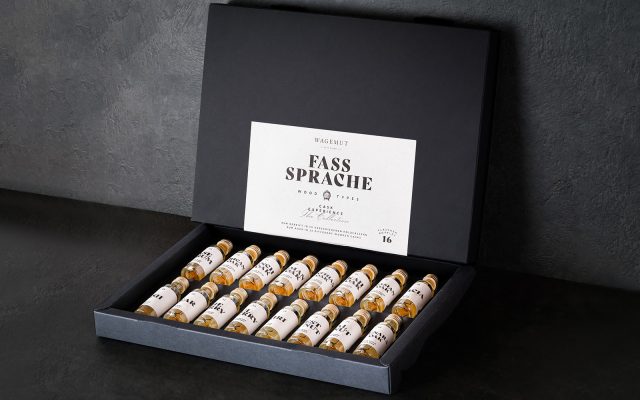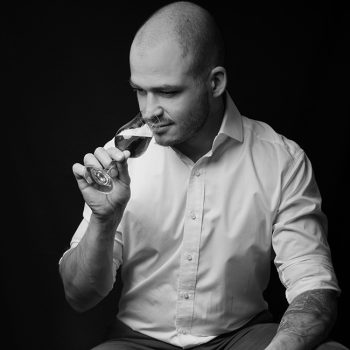This website uses cookies so that we can provide you with the best user experience possible. Cookie information is stored in your browser and performs functions such as recognising you when you return to our website and helping our team to understand which sections of the website you find most interesting and useful.
What impact does wood type have on an aged spirit?
By Lauren BowesCasks are a vital part of the aged spirit sector, but Nicolas Kröger, the founder of Wagemut, is taking things a step further by experimenting with different woods.

Tell me about your Fasssprache series.
I was visiting a cooperage that created beautiful casks out of different types of woods. I was so impressed by the smell of walnut, for example – walnut wood is just beautiful by itself, it smells amazing. That’s when I started to wonder what flavour impact a wood could have on a spirit.
I started thinking about all the other different types of wood, because in the spirits world – especially rum and single malt whisky – all we use is oak. Most of the time it’s American oak because of the Bourbon industry, and sometimes we get a bit fancy with French oak. Then we have different types of finishes – which are still oak, but instead of ex-Bourbon barrels, there used to be Sherry inside, for example. That is about as fancy as it gets. I thought that the world of wood had so much more to offer.
I looked for coopers, who helped me to build barrels out of every different type of wood I could get my hands on. I wanted new barrels to make sure that there was no impact from the spirit that used to be in the cask before. So we had new woods, which were all medium-toasted, and I aged the same base rum in the barrels and created a tasting set.
You can then discover the impact of the different types of wood, one next to the other. Maybe distillers will think: instead of a Sherry cask, maybe I could use cherry wood. They can decide for themselves if it would work with their products or not.

What is included in the set?
The tasting set has 16 samples, with 15 different types of wood – including different types of oak, so you can see the difference between French, German and American oak too.
I also created a video with one of the master coopers, who is like a wood chemist – he’s a real nerd, but in a very positive way. The video has nearly three hours of material, and we showed all aspects of cask production. We cover everything about wood – about the chemistry of wood, the impact of the wood and why the impact is a certain way.
It’s a great tool for anyone to learn about the impact of different woods.
And exactly what impact does a wood have on a spirit?
My particular focus is on rum. I’m very good with rum – when it comes to taste and smell, I’m very strong. But there have been samples where I’ve thought: ‘no chance is this rum’.
With certain woods, the amount of fruitiness you get – it tastes like an aged eaux-de-vie. Whereas with ash, for example, you get so much smokiness – not like a peated whisky, but a rich smoke that’s so well-involved in the spirit.
Then there are even fancier wood types, like kiri. It’s a very new type of wood – it’s not a natural type of wood. It’s a plantation wood, which is made in a lab. It’s totally supreme to oak, because it grows 10 times as fast and has only 30% of the weight.
At the beginning of the process, we put all the different oak types next to one another. And even with these classic oak types that we always use in the spirit industry, there is a massive difference. You can’t often get new American oak, because it’s usually been used to age Bourbon, so you always have the Bourbon impact. But did you know that the level of vanillin – the compound that gives a vanilla flavour – in American oak is 10 times higher than in French oak? When we used new American oak, the spirit tasted like a vanilla cookie.
Wagemut’s PX Cask rum won Gold at The Rum & Cachaça Masters 2024 – what inspired that expression?
This rum is our flagship. It’s a constant product that is always on the market. All of these other things are experiments, the single-cask bottlings and tasting sets. But this is our brand, the Wagemut PX Cask.
I used to run my own moonshine distillery in York, in North Yorkshire. It was so successful that I was thinking about quitting my job to produce more, but then I moved to London because I had a job offer at The Ritz London.
Then I opened a rum shop in Berlin. We had the biggest rum selection in Europe. We had more than 1,000 rums and all of them were available to sample. Everybody wanted to try these very successful rum brands, which were quite heavily sweetened. When I explained to the customers that the rums were so smooth because of the sugar, they were offended and wanted to try something more authentic.
So I gave them a sample, and they didn’t like it – they wanted the sweetness, but they didn’t want to be tricked by the industry. So, I took all my expertise in spirit making and I started creating products that the customer is demanding, but the market has not offered yet.
We aged rum in a very intense way, in Pedro Ximénez (PX) Sherry casks. PX is an extremely sweet Sherry – it contains close to 500 grams of sugar per litre. I have a deal with the Spanish government to import Sherry in bulk. I think I’m one of four people on Earth to have that. We import PX Sherry casks and refill them with Sherry. It’s an intense type of Sherry cask ageing, which no other producers can do, because nobody can get the Sherry this way.
Every time we fill the cask with rum, we reinfuse it with Sherry. That’s why it’s so intense. We get the smooth taste of fruitiness only from the PX, without adding any sugar, and that’s why we became quite successful, particularly in the German market.
What’s next for Wagemut?
I’m working on opening my own rum distillery because, at the moment, I don’t distil rum yet. I buy from rum all over the world, like from Foursquare in Barbados, and from distilleries in Jamaica and Trinidad. I blend them and age them, but we are in the middle of planning to create our own rums.

